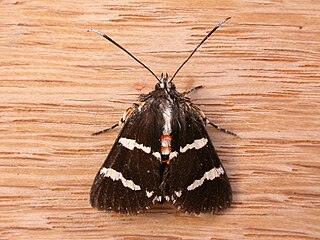
Amata is a genus of tiger moths in the family Erebidae. The genus was erected by Johan Christian Fabricius in 1807.

Cocytia is a monotypic moth genus in the family Erebidae. Its only species, Cocytia durvillii, is an uncommon day-flying moth found in lowland areas of the Moluccas, Aru, and New Guinea. The species has clear wings bordered with black, with an orange patch at the base of each forewing and long antennae, thicker at the outer end. Both the genus and species were first described by Jean Baptiste Boisduval in 1828.

Hecatesia is a genus of moths of the family Noctuidae. The genus was erected by Jean Baptiste Boisduval in 1829.
Amata humeralis is a species of moth of the family Erebidae first described by Arthur Gardiner Butler in 1876. It is found in Australia, where it has been recorded from Western Australia, the Northern Territory, Queensland and New South Wales.
Amata lampetis is a species of moth of the family Erebidae first described by Alfred Jefferis Turner in 1898. It is found in Australia.
Amata lucta is a species of moth of the family Erebidae first described by Hippolyte Lucas in 1901. It is found in Australia.
Amata marella is a species of moth of the family Erebidae first described by Arthur Gardiner Butler in 1876. It is found in Australia, where it has been recorded from Queensland.
Amata melitospila is a species of moth of the family Erebidae first described by Alfred Jefferis Turner in 1905. It is found in Australia, where it has been recorded from Queensland.
Amata nigriceps is a species of moth of the family Erebidae first described by Arthur Gardiner Butler in 1876. It is found in Australia, where it has been recorded from Queensland and New South Wales.
Amata paraula is a species of moth of the family Erebidae first described by Edward Meyrick in 1886. It is found in Australia, where it has been recorded from the Northern Territory and Queensland.
Amata recedens is a species of moth of the family Erebidae first described by Hippolyte Lucas in 1891. It is found in Australia.
Amata pyrocoma is a species of moth of the family Erebidae first described by Edward Meyrick in 1886. It is found in Australia.
Amata xanthosoma, the yellow tiger moth, is a species of moth of the family Erebidae first described by Alfred Jefferis Turner in 1898. It is found in the northern part of the Australian state of Western Australia.
Amata xanthura, the southern spotted tiger moth, is a species of moth of the family Erebidae. It was first described by Alfred Jefferis Turner in 1905. It is found in Australia, where it has been recorded from the Northern Territory, New South Wales and Victoria.
Amata annulata is a species of moth of the subfamily Arctiinae first described by Johan Christian Fabricius in 1775. It is found in Australia, New Guinea and the Philippines.
Amata aperta is a species of moth of the family Erebidae first described by Francis Walker in 1865. It is found in Australia and New Guinea.
Amata bicolor is a species of moth of the subfamily Arctiinae first described by Francis Walker in 1854. It is found in Queensland, Australia.



